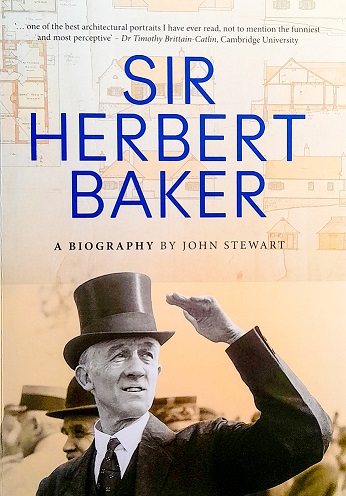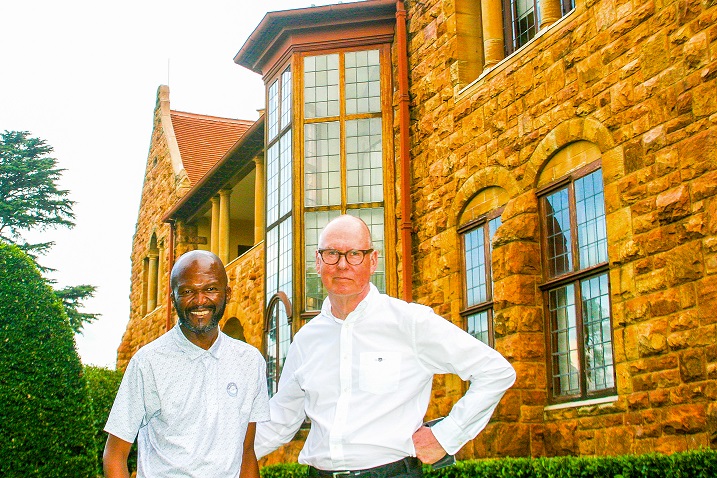OLD BEAR Baloo’s manifestation of a structure from what had been a government’s tabula rasa, is a masterclass in building on a hillside in the grand manner!
Elevated above the city of Pretoria, the symbol of government dominates South Africa’s capital on location which allows a higher plane for the country’s leaders to occupy in the style of the Acropolis in Athens or the Capitolium in Rome.
The view out offers distant views, inspiration and encouragement for its governors to “take the long view” – according to the architect and designer of the buildings.
The buildings are a fine three-dimensional composition in which their horizontal emphasis is balanced by the verticals of chimneys, towers and columns with the continuous eaves line of the Roman-tiled roof uniting the whole. Featuring Ionic porticos, two identical wings (with each having their own tower expressing the British and Dutch nations brought in peace to form a new South Africa on equal terms), and linked by a huge curved colonnade enclosing an amphitheater (per se an ancient symbol of assembly and debate) located at the very heart of the complex – the Union Buildings, unveiled in 1913, are British architect, Sir Herbert Baker’s greatest architectural achievement and crowning glory of his career in South Africa!
Pending their construction, Baker was so hands-on regarding the delivery of the commission that at some juncture while on-site, he is said to had “waged unending warfare with the contractors on quarry marks on a plinth or dark streaks in an otherwise uniform red granite column.” John Stewart – a fellow architect as well as author of this tome – would note that the consistent quality of the stately landmark’s detailing is remarkable: elegant molded string courses and window surrounds, well-proportioned voussoirs, balconies and pediments and while the entablature is a development of the one used at the station, the frieze is omitted with the top member of the architrave becoming the lower member of the cornice.
Constructed upon a site selected by Baker himself, the complex is also proof of an admirable skill he developed in South Africa: that of conceptualizing buildings located naturally upon rugged hillside sites. The Boer generals, Jan Smuts and Louis Botha – who approved of the site and the design of the complex, respectively – reasoned, in the words of Christopher Wren (an English architect whose masterpieces include London’s St Paul’s Cathedral), that: “Architecture has its political use, public buildings being the ornament of a country, establishes a nation, draws people and commerce and make people love their native country.”
(In a country which had recently amalgamated the Boer Republics and the British colonies into the Union of South Africa, the new country’s first Prime Minister General Louis Botha – despite criticism of a proposal to split the Parliament and administration of the new country – had no wish of seeing the Union Buildings being erected in Cape Town. And that Baker had the respect of these high-ranking Afrikaner politicians who, not long ago between the years 1899 to 1902, had been involved in battle against regiments of the British Empire he represented, in the Second Boer War – was testament of his own stature!)
The station Stewart alluded to is Pretoria Railway Station, the first symbol of the Union of South Africa and Baker’s first significant civic building commission for his burgeoning career. The seat of government in South Africa and the station were not the architect’s initial notable commissions in the early years of his stay in the country though, with the 1894–1898 converting and refurbishment of Groote Schuur for then Prime Minister of the Cape Colony Cecil John Rhodes – Baker’s first major domestic commission – among the noteworthy! Groote Schuur would offer Baker his first experiment in Cape Dutch architecture to which he integrated his first true Arts and Craft design (a style of design and architecture developed in England as a protest against mid-Victorian manufactured products.
The movement became an international revolt against mass-production and argued that the places in which you live and work build your character – hence the focus on artistry) as Rhodes accorded him laissez faire to deliver the ultimate masterpiece which from 1910 to 1984 became the official Cape residence of the Prime Ministers of South Africa, and on May 4, 1990, the site of the signing of the historic ‘Groote Schuur Minute’ between President F.W. de Klerk and the ANC’s Nelson Mandela.
Baker had disembarked at the then Cape Colony in 1892 from his native England. Having arrived with his younger brother to investigate a farming opportunity the latter had proposed as a panacea for the depressed financial situation his large family comprising of twelve children found itself in – the almost 30-year-old had no way of knowing that a commission (the Union Buildings) of such magnitude awaited him a few years further on!
Quadruple factors, viz: his befriending of mining magnate and fellow Englishman Cecil John Rhodes; an invitation by the then British High Commissioner for South Africa, Alfred Milner, to assist with the reconstruction of the Transvaal in the aftermath of the war against the Boer republics; patronage of “The Kindergarten Group” (fellow British circle some of whose members made Baker’s success upcountry in the Transvaal certain in the form of commissions and interventions); as well as the establishment of the Union of South Africa in 1910 – would prove to be catalysts which would transform Baker’s career and life immensely around the turn of the 20th century!
Baker developed an architectural approach that was responsive to the extremes of the climate and sensitive to local vernacular traditions. He dabbled in Gothic, Cape Dutch Revival, Classism (influenced by ancient empires of Rome and Greece), Jacobean and the Arts & Crafts Movement styles of architectural designs – some distinguished by his trademark H-plan (typified by a central atrium and two wings on either side of his buildings).
Additionally, he encouraged local artists and craftsmen to assist him in his work, built a team of capable assistants and provided professional leadership and training for the first time in the region.
After a Victorian architectural apprenticeship in London, Baker became the most prolific architect of his age in South Africa, delivering commissions of designs of myriad structures such as, St. George’s Cathedral in Cape Town, Rhodes University, South African Institute for Medical Research, Honoured Dead Memorial in Kimberley and St. John’s College in Johannesburg.
After 21 unparalleled years in the country, he went on to design the imperial capital of New Delhi in India – together with fellow British architect, Sir Edwin Lutyens (the designer of the Johannesburg Art Gallery). Working throughout the First World War, he also designed the South African War Memorial at Delville Wood in France – as well as the Bank of England, having relocated back to his homeland.
The undisputed Architect of the British Empire, Baker’s creations exist in erstwhile colonies incorporating Australia, Canada, Kenya, etcetera.
Baker’s name is included on the roll call of the greatest architects of the 19th, 20th and 21st century – et al., Le Corbusier (the designer of the Unite Nations headquarters) and Frank Lloyd Wright (creator of Fallingwater mansion) – to have been honoured with the Royal Institute of British Architects’ Royal Gold Medal (which he received in 1927) for an architect, of any nationality, who has made a truly outstanding contribution to the art of architecture!
Comprising varying enthralling facets of Baker’s life, this is the first full biography from childhood of the eminent architect, which Stewart wrote with the full cooperation of his family and with access to his archive and private papers.
Baker (referred to as old Bear Baloo by his wife, Florence) was a cherished friend of many fascinating men of his age, including ‘Poet of the Empire’, Rudyard Kipling, Lawrence of Arabia, General Jan Smuts, et al.
John Stewart is an award-winning architect, architectural historian, author and erstwhile leader of one of the UK’s largest multi-disciplinary architectural practices. He is a Fellow of the Royal Institute of British Architects and the Royal Society of Arts.
Stewart was educated at the Mackintosh School of Architecture, the Oxford School of Architecture and Henley Management College.
(The tome was launched – with Stewart present – at Northwards House, a 52-room mansion in Parktown dating from 1904 designed by Sir Herbert Baker for the Randlord, John Dale Lace.)
A trade paperback, Sir Herbert Baker is published by Jonathan Ball Publishers.
Available at leading bookstores countrywide, it retails for R400.
Top image (M Jacob Mawela and John Stewart, the author of Sir Herbert Baker, limned standing in front of Northwards House in Parktown).


